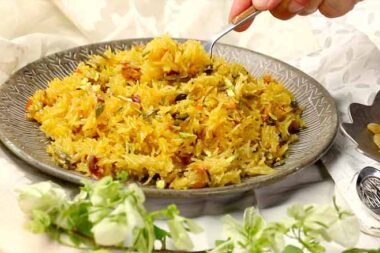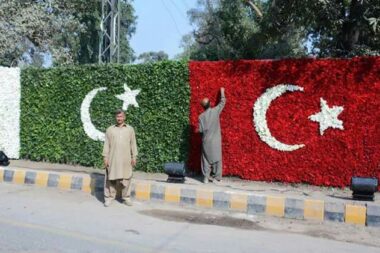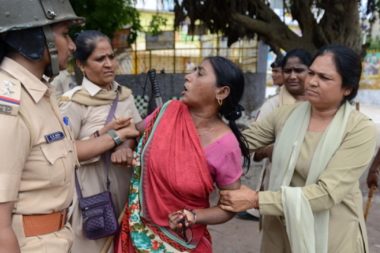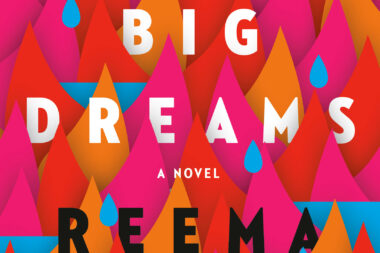By Marria Qibtia Sikandar Nagra
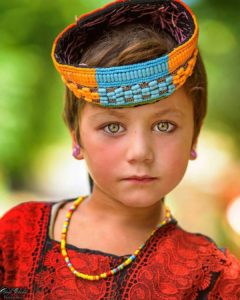 Genuine art serves as an integral spatial and physical construct, allowing for the convergence of ones dreams and aspirations. And when its exclusively the art of a pastoral community, it serves to illuminate the peoples treasured ideology and mindset. Weaving dreams in threads, articulating them in floral as well as geometrically embroidered patterns, the women of Kalash community narrate their quest for empowerment and autonomy through their artwork. In doing so, they rightfully qualify as “Dukhtars,” the daughters of a land who dare to dream big, displaying their skill set and artistic prowess fearlessly.
Genuine art serves as an integral spatial and physical construct, allowing for the convergence of ones dreams and aspirations. And when its exclusively the art of a pastoral community, it serves to illuminate the peoples treasured ideology and mindset. Weaving dreams in threads, articulating them in floral as well as geometrically embroidered patterns, the women of Kalash community narrate their quest for empowerment and autonomy through their artwork. In doing so, they rightfully qualify as “Dukhtars,” the daughters of a land who dare to dream big, displaying their skill set and artistic prowess fearlessly.
Settled in Pakistan’s Chitral district, the Kalash community dwells primarily in three main valleys: Rumbur, Birir and Bumboret. Believed to be the descendants of Alexander the Great’s Greek soldiers who followed him on his Indian campaign, the Kalash qualify as the smallest minority group in 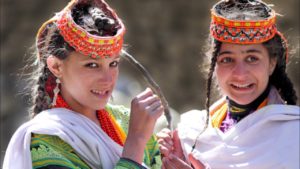 Pakistan with an estimated population of only about 3000 in total. Interestingly, unlike the gender disparity defining most of Pakistan’s conventional rustic communities, the Kalash women enjoy freedom in deciding upon significant life choices. During the colorful cultural seasonal festivals, these women have the authority to choose their life partners and even to elope with their lovers! For the members of this community, elopement is means of courtship culminating in marriage.The fact that this community encourages its women to court a potential partner before marriage, reflects its generalised liberal outlook. However, this does not entail that the Kalash women do not conform to conventionally defined roles at all. Despite possessing the agency to voice up on life choices, the women are expected to manage house work while men work at the farms.
Pakistan with an estimated population of only about 3000 in total. Interestingly, unlike the gender disparity defining most of Pakistan’s conventional rustic communities, the Kalash women enjoy freedom in deciding upon significant life choices. During the colorful cultural seasonal festivals, these women have the authority to choose their life partners and even to elope with their lovers! For the members of this community, elopement is means of courtship culminating in marriage.The fact that this community encourages its women to court a potential partner before marriage, reflects its generalised liberal outlook. However, this does not entail that the Kalash women do not conform to conventionally defined roles at all. Despite possessing the agency to voice up on life choices, the women are expected to manage house work while men work at the farms.
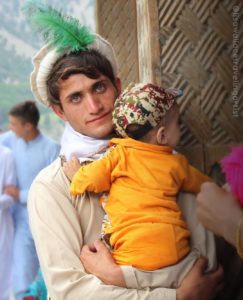 Since Kalash women are imparted respect by their community members, it is something that transpires in their autonomous and empowered posturing. This is what their artistic embroideries and colourful thread work at large displays. For decades, these embroideries have won the hearts of local as well as international tourists who happen to visit the valleys, charmed by its people and their enthralling culture. Not only that, the artistic density of the embroideries crafted by the Kalash women was deemed magnetic enough to be showcased on the international front. In 2019, Haitian-Italian designer Stella Jean visited Pakistan as a part of her project “Laboratory of Nations” as a means of promoting UN Strategic development Goals to empower women from rural areas in Pakistan.
Since Kalash women are imparted respect by their community members, it is something that transpires in their autonomous and empowered posturing. This is what their artistic embroideries and colourful thread work at large displays. For decades, these embroideries have won the hearts of local as well as international tourists who happen to visit the valleys, charmed by its people and their enthralling culture. Not only that, the artistic density of the embroideries crafted by the Kalash women was deemed magnetic enough to be showcased on the international front. In 2019, Haitian-Italian designer Stella Jean visited Pakistan as a part of her project “Laboratory of Nations” as a means of promoting UN Strategic development Goals to empower women from rural areas in Pakistan.
Living in the remote Kalash valley for a period of two weeks , Stella observed and assimilated the art that Kalash women engage in, to adorn their dresses.Impressed by its finesse and realising the danger of its extinction , Stella realised that this organic mode of art must be showcased to the world.So in order to raise awareness about the Kalash and to benefit their local economy, Stella in a collaborated with Chitral Women’s Handicrafts Foundation. As a consequence of the collaboration, 46 local artisans prepared around 4000 meters of embroidered material for her, which she designed and showcased at the Milan Fashion Week last year (2019).
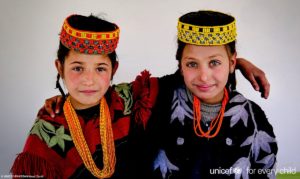 On the fashion runway, the embroideries crafted by the Kalash women, stitched into Jean’s beautiful summer dresses, with decorated hemlines and appealing belts was a proud moment for Pakistan since previously never had these embroideries ever made their way outside Kalash for public presentation. It would not be wrong to say that this moment was also a moment of reckoning for Pakistan. Reckoning of Pakistan’s artistic adequacy and talent store and the realisation that a failure to prevent the extinction of Kalash culture would rob us of this storehouse of impressionable invaluable skills. It also brought to light the tranquil and loving nature of the Kalash community.The embroideries by the Dukhtars of Kalash metaphorize the dictums of communal sharing and cultural transference. Cognizant of the need of bridging communal gaps through art, the Kalash women’s embroideries displays their wisdom. Had the Kalash not been a sagacious peace loving community , they would not have been eager to display their artistic prowess at an international front.On the converse, they would have expressed possessiveness of their artistic ventures. But the women went all out with their artistic displays, sharing it with the world, celebrating inclusivity as well as diversity.
On the fashion runway, the embroideries crafted by the Kalash women, stitched into Jean’s beautiful summer dresses, with decorated hemlines and appealing belts was a proud moment for Pakistan since previously never had these embroideries ever made their way outside Kalash for public presentation. It would not be wrong to say that this moment was also a moment of reckoning for Pakistan. Reckoning of Pakistan’s artistic adequacy and talent store and the realisation that a failure to prevent the extinction of Kalash culture would rob us of this storehouse of impressionable invaluable skills. It also brought to light the tranquil and loving nature of the Kalash community.The embroideries by the Dukhtars of Kalash metaphorize the dictums of communal sharing and cultural transference. Cognizant of the need of bridging communal gaps through art, the Kalash women’s embroideries displays their wisdom. Had the Kalash not been a sagacious peace loving community , they would not have been eager to display their artistic prowess at an international front.On the converse, they would have expressed possessiveness of their artistic ventures. But the women went all out with their artistic displays, sharing it with the world, celebrating inclusivity as well as diversity.
 Perhaps the major contributing factor in the Kalash women’s journey to self expression and autonomy through embroidered art has to be the degree of genuine respect their community imparts them with. There are of course, defined gender roles at play, but they do not compromise upon the women’s agency to express their selves, either verbally, physically or artistically.The women may work at homes, they may engage in domestic chores, but these do not take away from them their right to dream and aspire for themselves. They are not harassed against for daring to choose
Perhaps the major contributing factor in the Kalash women’s journey to self expression and autonomy through embroidered art has to be the degree of genuine respect their community imparts them with. There are of course, defined gender roles at play, but they do not compromise upon the women’s agency to express their selves, either verbally, physically or artistically.The women may work at homes, they may engage in domestic chores, but these do not take away from them their right to dream and aspire for themselves. They are not harassed against for daring to choose 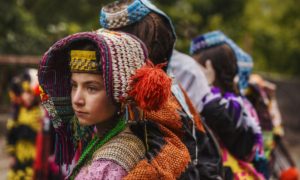 for themselves, for daring to prioritise themselves.With women coming forward from the pastoral community to attain formal education, and consequently have a proper vocation, if anything at all, this represents the unprecedented degree of wholesomeness the virtue of respect breeds in individuals.
for themselves, for daring to prioritise themselves.With women coming forward from the pastoral community to attain formal education, and consequently have a proper vocation, if anything at all, this represents the unprecedented degree of wholesomeness the virtue of respect breeds in individuals.
When communities cherish and celebrate their women, safeguarding their defined rights, what breeds is an empowered individual.This is what the “Dukhtars of Kalash” epitomise through their embroideries, empowered to dream on and dream high.



